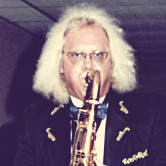Saxophonist John Conrath contacted me this past year obviously in distress over a recent accident and his inability to continue playing saxophone and flute. He described his problem, loss of part of his left hand ring finger, and at my request, sent photos of his injured hand. Some players would have just given up and quit playing—or switched instruments, picked up harmonica or drums—but not John. John was hesitant about soldering any type of extensions to the keys of his instruments. He was worried that if he found he could not play again, the modifications would greatly diminish their value from making and removing these modifications. After looking at photos John had sent me, I was sure we could solve this problem. I sent John pictures of key modifications I had done for other players, and of extensions my old friend, the late Santy Runyon, had done on his own instruments. Santy was missing a portion of his left little finger “from when (he) was a kid, (his) sister slammed the car door on it.” I figured for John it would be easy… the left hand ring finger has to work only one key! Such modifications would usually need to be done on a “cut and try” basis, with the player in my workshop. When I described to John the materials and methods I would use, he was certain he could do this himself… and that certainly proved to be the best solution in this case! Rather than fabricating and soldering on brass extensions to the G key touches of his tenor sax and flute, I suggested he use plexiglass, cut to shape, with the edges rounded and smoothed, and polished to a nice transparent finish. Further, I suggested an industrial craft glue, E6000, for attaching these key appliances. I have made wedges for octave key touches, low C and low Bb spatulas, and on one instrument, built up over the oval pearl of the chromatic F# key using shaped plexiglass pieces. Shaping is done by first rough cutting the basic shape with a jigsaw. Use a slow cutting speed, otherwise the plexiglass will melt on the blade. After cutting to shape, the piece may be further shaped with a cylindrical mill bit on a Dremel Tool ®. Once the desired shape is achieved—and through trial and error, it may require making several pieces before obtaining the desired result—the key appliance may be polished to make it completely transparent. This is done by first removing the scratches from cutting and shaping. Begin the polishing process by hand sanding, first with 400 grit silicon carbide paper, then 600, then 800, and finally 1000 grit. Now polish using a 1” cloth buffing wheel with the Dremel Tool ® and a suitable polishing compound. I have successfully used Kit Scratch Out (a plastic polish from automotive stores), Flitz Metal Polish, and even Colgate white toothpaste. With the toothpaste it helps to wet the cloth buffing wheel and to add a few drops of water every so often. Go slowly, use the slowest speed and very light pressure, otherwise the plexiglass will melt. Finish by hand buffing with a soft cloth. By now the key appliance should be perfectly clear. The glue mentioned earlier, E6000, is described by the manufacturer as a “SBR Adhesive”. SBR, it was explained, stands for Styrene Butadyene Rubber. This glue is quite thick, thicker than epoxy, and glass clear. The clear glue and plexiglass will allow the color of the key’s pearl, or the lacquered brass or plated finish to show through. From a few feet away, these key appliances are all but invisible. And even better, they may be removed, the glue scraped away with a fingernail, and there will be no damage to the instrument’s finish. The process is entirely reversible. The adhesive is applied to both surfaces to be glued, and then waiting a few minutes. This lets excess solvents escape from the glue. Now press the two pieces together. At this time do not worry about any excess glue oozing from between the pieces. Let it dry for a few hours. The excess may then be scraped away with a fingernail. I suggest waiting at least overnight before using the instrument. This type of glue is very slightly flexible, but not soft and squishy like silicone rubber. This flexibility allows good long-term adhesion of dissimilar materials, metal to plastic for example. Another similar SBR adhesive is Alene’s 7800, a slightly thinner material. E6000 and Alene’s 7800 are available in the craft department at Walmart stores and in many craft, hobby, and hardware stores. John was able to successfully fit key appliances to his saxophone and flute. I further suggested to John that he could obtain (on special order from G. Leblanc Corp, www.gleblanc.com), a Noblet wood clarinet body fitted with Vito “plateau model” keys, and he could then use this same method for fitting the clarinet to his hand. Now, I turn this article over to John Conrath. ~Paul R. Coats Playing Again!, John Conrath I’m John Conrath from Newark, OH. I’ve been playing the saxophone since the age of 9, and gigging professionally since the age of 13. I had a lawnmower accident last year. I was devastated… I sold all of my horns and flute because I felt that I could never play again. In the last few months, I felt I had regained enough dexterity and strength in my injured hand to try playing again. I bought a new horn and flute…a Guardala 500BN Tenor Saxophone and a Yamaha YFL-421 Flute. After several failed attempts using a synthetic prosthetic, I contacted Paul Coats. He gave me some great ideas and I ran with them. I am back playing again, with little notice of the loss of my finger! I hope some of you will find the following gallery helpful. If you have any questions, don’t hesitate to email me. Picture Descriptions:
[insert images from diagrams...text instructions included below]
- Left Hand
- Hand position on sax
- Hand position on flute
- Cutting paper template for sax
- Cutting paper template for flute
- Refining paper template for sax
- Refining paper template for flute
- 5/8″ Lexan. I am using thick stock so I can shape it to fit later on. Traced templates and ready to cut out.
- Using jigsaw w/jig blade, I cut out pieces.
- Time to shape out pieces. Using a Dremel with very abrasive drum sander.
- Using template as guide to shape out exact measurements.
- Piece after about 15 minutes. Notice shape…I tried to get it to fit my finger and the instrument as well as I could. It’s very important to note that I beveled out the back of the piece to fit down over the key like a glove. This will maximize contact with the surface when I use the adhesive later on.
- Finished pieces. To get the pieces to turn clear, I used a low speed cloth wheel and toothpaste and the Dremel Tool ®.
- Paul Coats suggested I use E6000 instead of contact cement. I’m glad I did. Not only does it have better holding power, but it allowed me to adjust the piece as I applied it to the instrument for an exact fit to my hand. This adhesive will come off as well if I ever decide to sell the instrument without hurting the surface. Once I applied the piece, I waited 72 hours before trying it out.
- Piece on saxophone
- Piece on flute
- Finished product and ready to play!
[end diagrams and instructions]
Notes from Paul Coats: I would like to thank John for joining me as co-author of this article. I received a wonderful call from John shortly after he made these modifications. “I played a gig last night and didn’t once think about my finger!” Man, THAT is what it is all about! The music! I would also like to thank Gunnar Mossblad, Saxophone Journal columnist (www.dornpub.com) for his inspirational two-part article about his experience with Bell’s Palsey, and his prosthetic work that allowed him to continue performing during that ordeal. I would hope this article, and Gunnar’s, will encourage players who encounter physical problems to not just give up, but to “think outside the box”. ~Paul R. Coats


